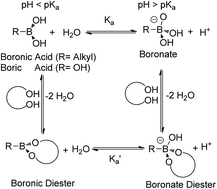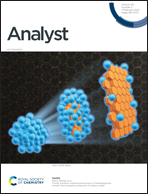Boronic acid sensors with double recognition sites: a review
Abstract
Boronic acids reversibly and covalently bind to Lewis bases and polyols, which facilitated the development of a large number of chemical sensors to recognize carbohydrates, catecholamines, ions, hydrogen peroxide, and so on. However, as the binding mechanism of boronic acids and analytes is not very clear, it is still a challenge to discover sensors with high affinity and selectivity. In this review, boronic acid sensors with two recognition sites, including diboronic acid sensors, and monoboronic acid sensors having another group or binding moiety, are summarized. Owing to double recognition sites working synergistically, the binding affinity and selectivity of sensors can be improved significantly. This review may help researchers to sort out the binding rules and develop ideal boronic acid-based sensors.



 Please wait while we load your content...
Please wait while we load your content...